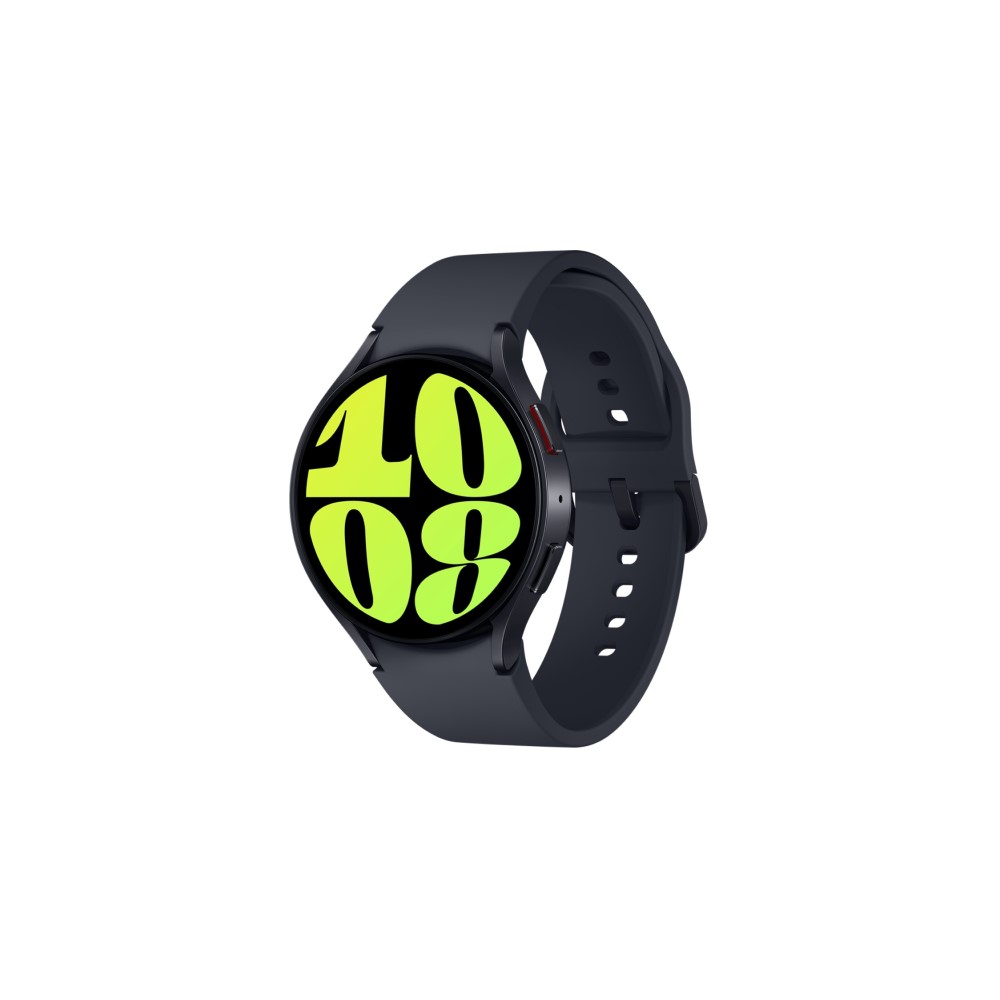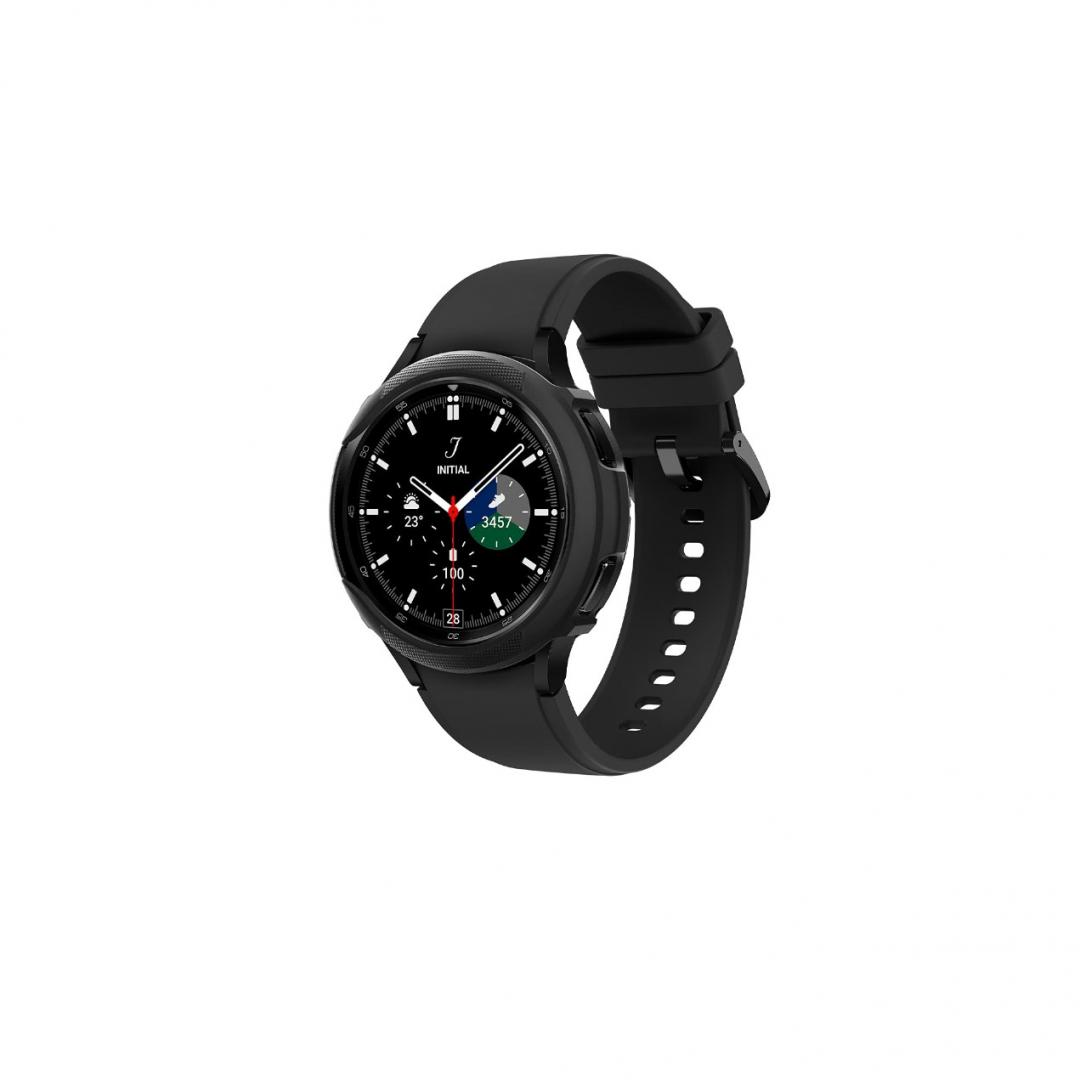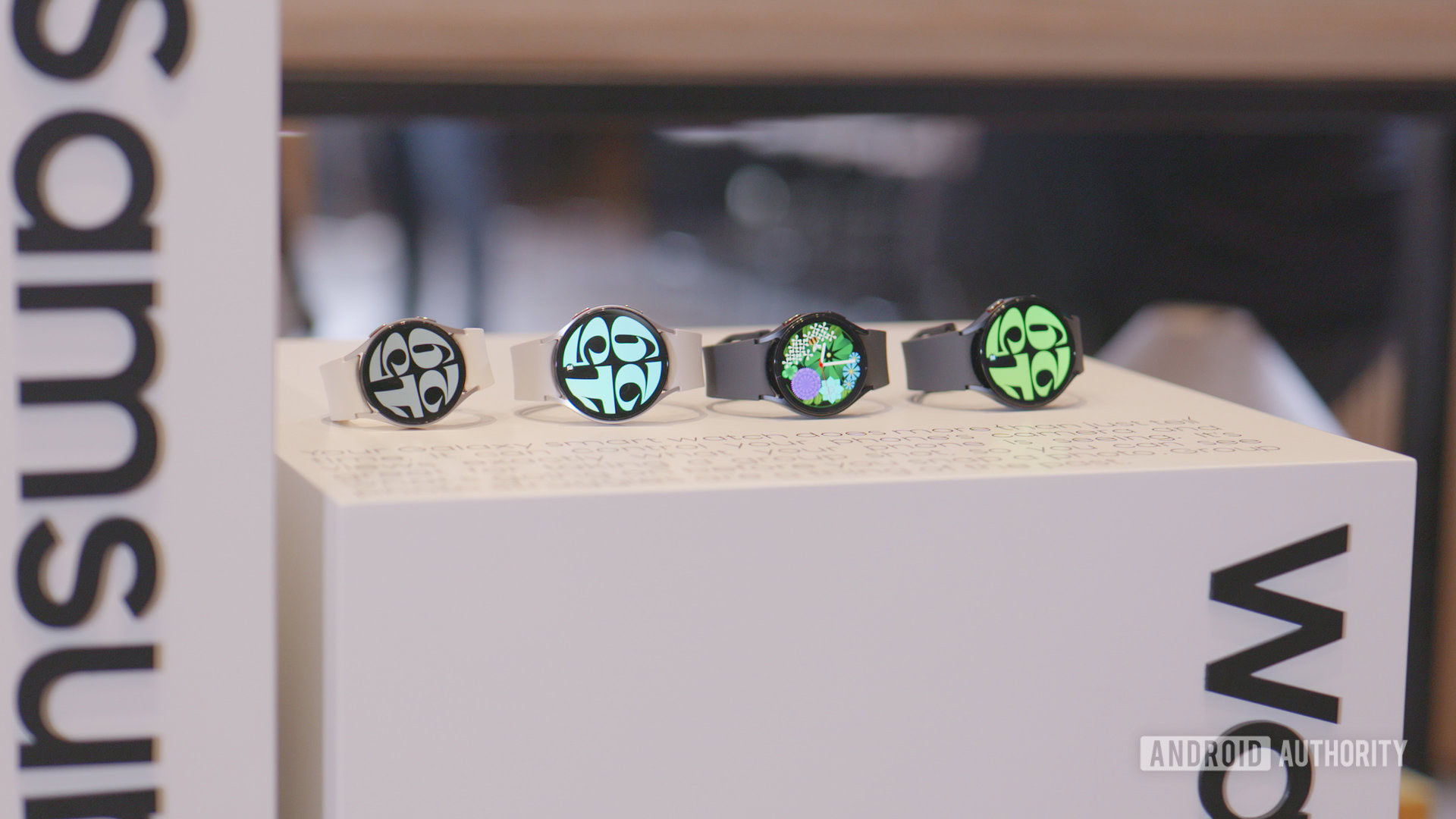Affiliate links on Android Authority may earn us a commission. Learn more.
Samsung Galaxy Watch 6 vs Galaxy Watch 4: Is it worth the upgrade?
Published onJune 14, 2024








The third generation of Samsung’s new Wear OS smartwatch line is now official. The Samsung Galaxy Watch 6 heralds the return of the Classic model, brings larger batteries and screens and includes a more refined design. But is it worth upgrading if you own an older model, like the Galaxy Watch 4? Read our Samsung Galaxy Watch 6 vs Galaxy Watch 4 comparison to learn more.
Samsung Galaxy Watch 6 vs Galaxy Watch 4: At a glance
Picking between two of the best smartwatches is a tough task, so here's a quick summary of the big differences between the Galaxy Watch 6 and the Galaxy Watch 4:
- The Samsung Galaxy Watch 4 series is cheaper than the Galaxy Watch 6 line.
- Samsung's Galaxy Watch 6 series has larger displays than the Galaxy Watch 4.
- The Galaxy Watch 6 series also has narrower bezels than the Galaxy Watch 4, but its body is slightly larger in all dimensions.
- The Galaxy Watch 4 line lacks the temperature sensor found on the Galaxy Watch 6 series.
- The Galaxy Watch 6 series features a more modern, powerful chipset than the Galaxy Watch 4 line.
- The Galaxy Watch 6 series has larger batteries than the Galaxy Watch 4 line.
Samsung Galaxy Watch 6 vs Galaxy Watch 4 specs
| Samsung Galaxy Watch 4 | Samsung Galaxy Watch 6 | |
|---|---|---|
Display | Samsung Galaxy Watch 4 44mm: 1.36-inch Super AMOLED 450 x 450 resolution Full color Always On Display Corning Gorilla Glass with DX+ 40mm: 1.19-inch Super AMOLED 396 x 396 resolution Full color Always On Display Corning Gorilla Glass with DX+ | Samsung Galaxy Watch 6 44mm: 1.5-inch Super AMOLED 480 x 480 resolution Full color Always On Display Sapphire Crystal 40mm: 1.3-inch Super AMOLED 432 x 432 resolution Full color Always On Display Sapphire Crystal |
Dimensions and weight | Samsung Galaxy Watch 4 44mm: 44.4 x 43.3 x 9.8mm 30.3g 40mm: 40.4 x 39.3 x 9.8mm 25.9g | Samsung Galaxy Watch 6 44mm: 44.4 x 42.8 x 9.0mm 33.3g 40mm: 40.4 x 38.8 x 9.0mm 28.7g |
Colors and materials | Samsung Galaxy Watch 4 Aluminum case Sport Band 44mm: Graphite, Silver, Sapphire 40mm: Graphite, Silver, Pink Gold | Samsung Galaxy Watch 6 Armor Aluminum case Sport Band 44mm: Graphite, Silver 40mm: Graphite, Gold |
Battery | Samsung Galaxy Watch 4 44mm: 361mAh 40mm: 247mAh WPC-based wireless charging WPC-based wireless charging | Samsung Galaxy Watch 6 44mm: 425mAh 40mm: 300mAh WPC-based wireless charging |
Processor | Samsung Galaxy Watch 4 Samsung Exynos W920 Dual-core 1.18GHz | Samsung Galaxy Watch 6 Samsung Exynos W930 Dual-core 1.4GHz |
RAM | Samsung Galaxy Watch 4 1.5GB | Samsung Galaxy Watch 6 2GB |
Storage | Samsung Galaxy Watch 4 16GB | Samsung Galaxy Watch 6 16GB |
Connectivity | Samsung Galaxy Watch 4 LTE (available in select models) Bluetooth 5.0 Wi-Fi 802.11 a/b/g/n 2.4+5GHz NFC GPS/GLONASS/Beidou, Galileo | Samsung Galaxy Watch 6 LTE Bluetooth 5.3 Wi-Fi 802.11 a/b/g/n 2.4+5GHz NFC GPS/GLONASS/Beidou/Galileo |
Sensors | Samsung Galaxy Watch 4 Accelerometer Barometer Gyroscope Geomagnetic sensor Ambient light sensor Samsung BioActive sensor: optical heart rate (PPG), electrocardiogram (ECG), bioelectrical impedance analysis sensor (BIA) | Samsung Galaxy Watch 6 Accelerometer Barometer Gyroscope Geomagnetic sensor Light sensor Temperature sensor Samsung BioActive sensor: optical heart rate (PPG), electric heart signal, bioelectrical impedance analysis sensor (BIA) |
Durability | Samsung Galaxy Watch 4 5ATM + IP68 MIL-STD-810G | Samsung Galaxy Watch 6 5ATM + IP68 MIL-STD-810H |
Software | Samsung Galaxy Watch 4 Wear OS 3 One UI Watch | Samsung Galaxy Watch 6 Wear OS 4 One UI 5 Watch |
Compatibility | Samsung Galaxy Watch 4 Android | Samsung Galaxy Watch 6 Android |
Galaxy Watch 6 vs Galaxy Watch 4: Features

Regarding features, the Galaxy Watch 6 and the Galaxy Watch 4 are closely matched. We’ll first mention what the new watch brings to the table.
The Galaxy Watch 6 series packs the Exynos W930 chipset with 2GB of RAM and 16GB of internal storage. The sprightlier chip and slightly more RAM should make for an overall more fluid experience. Powering this system is a 425mAh battery for the larger models and a 300mAh battery for the smaller options. The Galaxy Watch 6 models feature larger batteries than the Galaxy Watch 4, which bodes well for longevity. Samsung claims you can get up to 40 hours of use on the Galaxy Watch 6 without the always-on display activated. This would match our experiences with the Galaxy Watch 4. Notably, around 30 hours with the always-on display activated on the new watch. It’s the battery champ here.
Samsung hasn't adorned the Galaxy Watch 6 with many new sensors.
Samsung hasn’t adorned the Galaxy Watch 6 with many new sensors. Apart from a bezel sensor on the Classic, you’re still getting a similar fitness tracking loadout seen on the Galaxy Watch 4 and 5, including the BioActive sensor trio (heart rate sensor, ECG, and body composition sensor) with SpO2 monitoring. The Galaxy Watch 6 does benefit from the skin temperature sensor, which first debuted on the Galaxy Watch 5. This sensor now has a broader purpose, too, allowing users to take the temperature reading of objects. Samsung gives an example of testing the water temperature of a pool before hopping in. Interestingly, the company has opened up the temperature sensor’s API. We could see some useful third-party apps soon.
Many of the Galaxy Watch 6’s true novel features come from its new software. One UI 5 Watch running on top of Wear OS 4 brings more intricate sleep tracking, a run tracking feature, and a custom workout builder to the wrist. A new UI with the promise of new Google apps also awaits. However, these features are no longer exclusive, as the Galaxy Watch 4 has since received the software bump.
Galaxy Watch 6 vs Galaxy Watch 4: Design
The Galaxy Watch 6 series provides a textbook example of iterative upgrades. Aesthetically, it looks almost exactly like the Galaxy Watch 4, but there are some changes. We quite like the bolder strap pylons that encompass the display on the standard model. You may notice the much narrower bezels on the new watch, and it’s apparent when holding these two devices alongside one another. Samsung increased the screen real estate to 1.5 inches on the larger model and 1.3 inches on the smaller offering without substantially enlarging the Galaxy Watch 6’s body. That’s a great deal in our book.
Notably, the Galaxy Watch 6 series also sees the return of the Classic model. Like the chunkier Galaxy Watch 4 Classic, the new model includes a physical rotating bezel surrounding its display, but it’s much slimmer and tidier than its predecessor. While the Classic is a larger device, its display gives away a few millimeters to accommodate the ring.
Let’s talk about the size options on offer. The standard Galaxy Watch 6 and 4 models share dial size options. You can have either a 40mm or 44mm dial. However, the Galaxy Watch 6 looks larger thanks to the tighter bezels and larger overall display, but in reality, it’s more compact. Samsung has tweaked the Classic model sizes ever so slightly. The Galaxy Watch 6 Classic has a 43mm or 47mm face, overshadowing the Galaxy Watch 4 Classic’s 42mm and 46mm flavors. In general, the new Classic is a larger smartwatch than all the other devices listed above. We feel the standard models will be more comfortable as gym companions.
Interestingly, the Galaxy Watch 6 does bring one fundamental change to its design that’ll likely go unnoticed by many. The device reworked its band strap mounting system, now using a pill-shaped button to release or attach watch bands. This makes changing bands on the new watch an absolute breeze.
In summary, both Galaxy Watch 6 models appear larger than the Galaxy Watch 4 line, owing to roomier displays. In comparison, the 2021 smartwatches look decidedly stuffy.
Samsung Galaxy Watch 6 vs Galaxy Watch 4: Price and colors
- Samsung Galaxy Watch 6: Starts at $299
- Samsung Galaxy Watch 6 Classic: Starts at $399
- Samsung Galaxy Watch 4: Launched at $279
- Samsung Galaxy Watch 4 Classic: Launched at $329
The Samsung Galaxy Watch 4 launched in 2021, with prices starting at $279 for the 40mm standard model. The Classic model had a $50 premium. Thankfully, you have a much better chance of finding this device at a lower price, making it a decent option if you’re budget limited.
The standard model’s colors include a playful Pink Gold option exclusive to the 40mm dial and Black, Green, and Silver options shared across the two sizes. The Classic is available in Black and Silver.




The Samsung Galaxy Watch 6 series debuted on July 26, 2023, with general availability starting on August 11. The series starts at $299 for the 40mm standard model — a $20 price hike over the 2021 model. The Classic alternative is now even more expensive at $399. That’s a $70 price hike over the Galaxy Watch 4 Classic and a $100 premium over the standard Galaxy Watch 6. Those who pre-order the device will also receive a free Fabric Band. Trading in an older device could also earn you a $250 price drop.
Colorways include Graphite, Silver, and Gold for the standard model and Black and Silver for the Classic.




Samsung Galaxy Watch 6 vs Galaxy Watch 4: Should you upgrade?
The Galaxy Watch line has adopted the Apple Watch approach of iterative upgrades, which might confuse some fans eager for cutting-edge features. We’re glad to see the return of the Classic model, but is that enough to entice legacy users from upgrading? While the Galaxy Watch 6 isn’t significantly different from the Galaxy Watch 4, it is a more complete smartwatch. It’s the better option for smartwatch newcomers.
The roomier display, larger batteries, and newer chipset make the Galaxy Watch 6 a more efficient and easier-to-use wearable.
The roomier display, larger batteries, smarter band design, and newer chipset make the Galaxy Watch 6 a more efficient and easier-to-use wearable. The return of the Classic model also gives users pining for a rotating bezel a worthwhile option again. However, if you were looking for a new killer feature, you won’t find any on the new models.
The Galaxy Watch 4 is still a capable fitness tracker and smartwatch with a few years of support pending. If you own a Galaxy Watch 4, there’s no real reason to upgrade unless you want the new Galaxy Watch 6 Classic.
That’s it for our Galaxy Watch 6 vs Galaxy Watch 4 comparison. Do you prefer the new or the old watch? Let us know in the poll below.